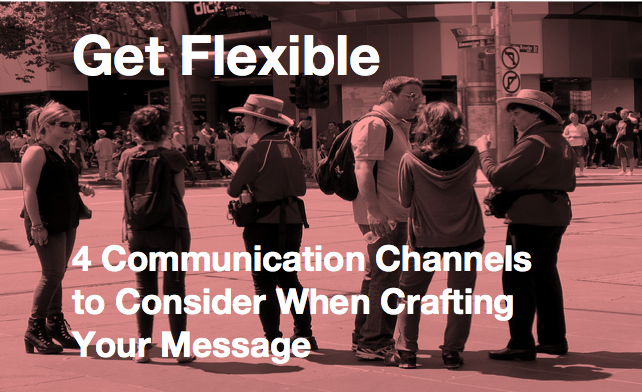
Get Flexible: 4 Communication Channels to Consider When Crafting a Message
Last month I wrote about how the meaning of your communication is the response you get, measured by the other person’s behavior. In that post, I mentioned that communication gaps can be prevented if the communicator is more flexible to meet the needs of the listener. This is so important to successful communication that I wanted to dig deep on one specific way to improve your communication.
Four Communication Channels
Imagine you are strolling down the streets of Paris and want directions. You can hear the locals chatting away, so you stop at a coffee shop and ask for help. Do you ask in English or French? If English is the only language you know, then that will be your preference, and will likely meet with only limited success. What if you were flexible and skilled enough to switch languages on the fly to meet their needs? While many of us do not have the time, inclination, or need to learn a new language, how we structure our communication in our own language can create a similar effect.
There are four main communication channels to consider when crafting your message:
- Visual: People operating in this channel prefer images and pictures to help them fully receive the message. This could entail standing at the white board and animating the idea in your head, or even helping them to see the images in their own mind’s eye. Imagine a bright, sunny day with rich blue skies and fluffy white clouds occasionally shading the sun during your afternoon walk.
- Auditory: Folks here want to listen to the words, tone, and stories you have to offer. Consider mimicking the sounds of the thing you are describing, whether it be a crash or a boom or a soothing wave. Listen to the birds chirp and sing as the water bubbles in the stream. You hear your heartbeat slowing down and your footprints whispering in the grass.
- Kinesthetic: How does it feel? Your message here can draw on emotions or a tactile experience to provide awareness. Consider that passionate analogy that connects our hearts together. Lift your face to feel the warmth of the sun as the blades of grass slip between your toes. Sip that ice-cold drink and relax for the first time in days.
- Digital: This communication channel is devoid of the senses and is very logical. Often list-based, this mode involves thinking things through to arrive at the best conclusion or processing the facts and figures until a decision can be made. In addition, Digital thinking will move step by step in a predictable and repeatable sequence. I have decided to walk 10,000 steps per day to increase my health and I am currently 2/3 of the way through that today.
Does one of these four resonate with you more than others? Can you see these patterns in others around you? Does one of these snippets feel more right, or does one make more sense than the others?
Your Next Move
The first step in gaining flexibility is knowing your natural preferences and learning to expand to use other channels. As you increase your flexibility to communicate in just the way your listener prefers, watch how quickly rapport deepens and communication improves.
Would you like to learn more about the four types of communication channels? Connect with an Auxano Navigator and start a conversation with our team.

Tags: Communication Channels, Dave Bair











